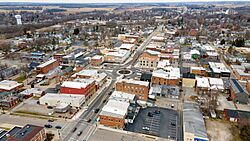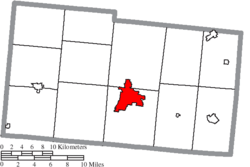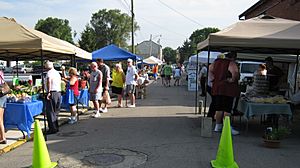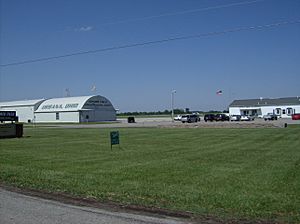Urbana, Ohio facts for kids
Quick facts for kids
Urbana, Ohio
|
|
|---|---|

Downtown Urbana
|
|

Location of Urbana in Champaign County
|
|
| Country | United States |
| State | Ohio |
| County | Champaign |
| Area | |
| • Total | 7.91 sq mi (20.49 km2) |
| • Land | 7.91 sq mi (20.49 km2) |
| • Water | 0.00 sq mi (0.00 km2) |
| Elevation | 1,043 ft (318 m) |
| Population
(2020)
|
|
| • Total | 11,115 |
| • Density | 1,405.18/sq mi (542.54/km2) |
| Time zone | UTC-5 (Eastern (EST)) |
| • Summer (DST) | UTC-4 (EDT) |
| ZIP code |
43078
|
| Area code(s) | 937, 326 |
| FIPS code | 39-79072 |
| GNIS feature ID | 2397096 |
| Website | http://urbanaohio.com/ |
Urbana is a city in Ohio, United States. It is the main town of Champaign County. Urbana is about 34 miles (55 km) northeast of Dayton and 41 miles (66 km) west of Columbus. In 2020, about 11,115 people lived there.
Urbana was started in 1805. For a short time in 1812, it was the main base for the Northwestern army during the War of 1812. The famous explorer and soldier Simon Kenton is buried in Urbana. The city was once home to Urbana University and Curry Normal and Industrial Institute, a school for African American students.
Contents
History of Urbana
Champaign County was created on February 20, 1805. This happened after the American Revolution and the Northwest Indian War.
How Urbana Was Founded
Colonel William Ward was a man from Virginia. He settled near the Mad River Valley in 1799 with Simon Kenton. Ward bought 160 acres of land. He thought it was the best place for the county seat of Champaign.
He suggested to the county leaders that the new county seat be on his land. Ward offered to divide the land into 212 lots and 22 out-lots. He would give half of these lots to the county. Ward also offered two lots for a cemetery and a public square. The county leaders agreed. Ward and Joseph C. Vance made a written agreement on October 11, 1805. They named the new county seat Urbana.
The Name Urbana
No one is completely sure where the name 'Urbana' came from. Many people think Ward and Vance used the Latin word urbs, which means city.
One idea is that Colonel Ward named it after the word Urbanity, meaning politeness. Another idea is that it came from an old Roman custom. Romans divided people into groups. Plebs Urbana were people who lived in towns and worked as mechanics or artisans.
Some people think it was named after a town in Virginia called Urbanna. But this seems unlikely. Urbanna means 'City of Anne' and was named for an English queen. It is more likely that two American Revolution veterans would use a Latin word instead of honoring their former enemy. A study in 1939 showed that Urbana, Ohio, was the first of 12 cities in the United States named "Urbana."
Planning the City
When Ward asked Vance to map out the town, there were no other planned towns between Detroit and Springfield. But Vance and Ward planned Urbana very carefully. They made sure there was a large public square. They also laid out the streets in a neat order, even avoiding wet or swampy areas.
By 1833, Urbana had a courthouse, a jail, a printing office, a church, a market, nine stores, and 120 houses.
Melvin Miller Park Skatepark
On June 21, 2009, a skatepark was added to Urbana's Melvin Miller Park. Kevin Shockey designed it, and Yoder Concrete Construction built it. In November 2013, a local skateboarder named Damien Pendergast passed away. His high school class raised $700 to dedicate the skatepark in his name.
Geography of Urbana
Urbana is located at 40°6′39″N 83°45′5″W / 40.11083°N 83.75139°W.
The United States Census Bureau says the city covers about 7.77 square miles (20.13 km2). Almost all of this area, 7.75 square miles (20.07 km2), is land. Only a tiny part, 0.02 square miles (0.05 km2), is water.
Population and People
| Historical population | |||
|---|---|---|---|
| Census | Pop. | %± | |
| 1820 | 644 | — | |
| 1830 | 1,102 | 71.1% | |
| 1840 | 1,070 | −2.9% | |
| 1850 | 2,020 | 88.8% | |
| 1860 | 3,429 | 69.8% | |
| 1870 | 4,276 | 24.7% | |
| 1880 | 6,252 | 46.2% | |
| 1890 | 6,510 | 4.1% | |
| 1900 | 6,808 | 4.6% | |
| 1910 | 7,739 | 13.7% | |
| 1920 | 7,621 | −1.5% | |
| 1930 | 7,742 | 1.6% | |
| 1940 | 8,335 | 7.7% | |
| 1950 | 9,335 | 12.0% | |
| 1960 | 10,461 | 12.1% | |
| 1970 | 11,237 | 7.4% | |
| 1980 | 10,774 | −4.1% | |
| 1990 | 11,353 | 5.4% | |
| 2000 | 11,613 | 2.3% | |
| 2010 | 11,793 | 1.5% | |
| 2020 | 11,115 | −5.7% | |
| 2021 (est.) | 11,125 | −5.7% | |
Urbana in 2010
In 2010, there were 11,793 people living in Urbana. There were 4,808 households and 2,932 families. The city had about 1,521 people per square mile (587 per km2).
Most people in Urbana were White (89.7%). About 5.4% were African American. Other groups included Native American, Asian, and people of two or more races. About 2.0% of the population was Hispanic or Latino.
About 31% of households had children under 18. The average household had 2.34 people. The average family had 2.95 people. The average age in the city was 38.2 years old.
Economy and Businesses
Many companies have offices or factories in Urbana. These include Rittal, Honeywell Aerospace, Control Industries, Freshwater Farms, and Bolder & Co Creative Studio.
The Urbana Monument Square Historic District has many services. You can find banks, accounting offices, restaurants, and personal care businesses there. The Champaign County Farmers Market is held every week in downtown Urbana. It was even voted one of America's favorite farmers' markets! Urbana also hosts the yearly Simon Kenton Chili Cook-Off downtown.
Education in Urbana
Urbana is mainly served by the Urbana City School District. This includes Urbana High School for grades 9-12. There is also a building for pre-kindergarten through 8th grade. Both new school buildings were finished in 2018. The old high school building, which looked like a castle, is no longer used.
Urbana was home to Urbana University from 1850 until 2020. It was a small college where students could study many different subjects. It offered 28 undergraduate degrees and graduate degrees in business, criminal justice, education, and nursing.
Urbana also has a public library. It is a part of the Champaign County Public Library system.
City Infrastructure
- Urbana was a stop on the Pittsburgh, Cincinnati, Chicago and St. Louis Railroad. This railroad connected cities like Pittsburgh to Chicago and St. Louis.
- Urbana has its own airport called Grimes Field. This airport is home to the Champaign Aviation Museum. The museum is known for restoring old planes, like a Boeing B-17 Flying Fortress.
Famous People from Urbana
- Clancy Brown – An actor and producer, born in Urbana in 1959.
- Clarence J. "Bud" Brown Jr. – A US Representative (1965 to 1983) and former publisher of the Urbana Daily Citizen.
- Call Cobbs Jr. (1911-1971) – A jazz pianist and organist.
- Moses Bledso Corwin – A lawyer and member of the United States House of Representatives.
- Andy Detwiler – A farmer.
- Elias Franklin Drake – A politician and businessman, born in Urbana.
- Pete Dye – A golf course designer who grew up in Urbana. He is in the Hall of Fame.
- Robert Morton Duncan – A lawyer and judge.
- Robert L. Eichelberger – A United States Army general during World War II.
- Warren G. Grimes (1898–1975) – Known as the "Father of the Aircraft Lighting Industry."
- Charles T. Hinde – A businessman and riverboat captain.
- Edmund C. Hinde – A miner during the California Gold Rush.
- Robert R. Hitt – A United States Assistant Secretary of State, born in Urbana in 1834.
- Raymond Hubbell – A composer of musicals, including the song "Poor Butterfly".
- Jim Jordan – A Representative for Ohio's 4th district.
- Michael Kent – A comedian and magician.
- Simon Kenton – A famous frontiersman; buried in Urbana.
- Tony Locke – An Arena Football League wide receiver.
- Beth Macy – A journalist and writer; grew up in Urbana.
- Joseph Vance – The 13th Governor of Ohio; lived in Urbana.
- Martin R. M. Wallace – A Civil War general, born in Urbana.
- W. H. L. Wallace – A Civil War general, born in Urbana.
- Colonel William Ward – The founder of Urbana.
- John Quincy Adams Ward – A sculptor, known for the George Washington statue in New York City.
- Edgar Melville Ward – A painter and educator.
- Brand Whitlock – Born and raised in Urbana; he was mayor of Toledo, Ohio four times.
See also
 In Spanish: Urbana (Ohio) para niños
In Spanish: Urbana (Ohio) para niños





